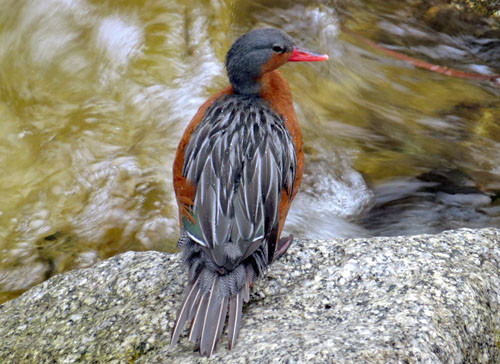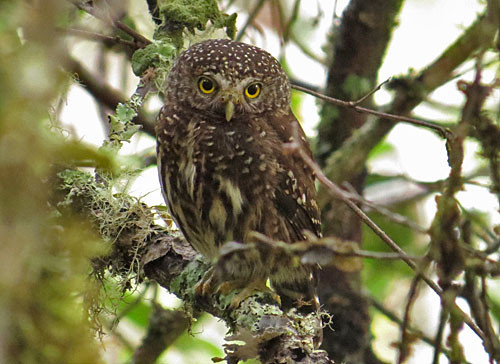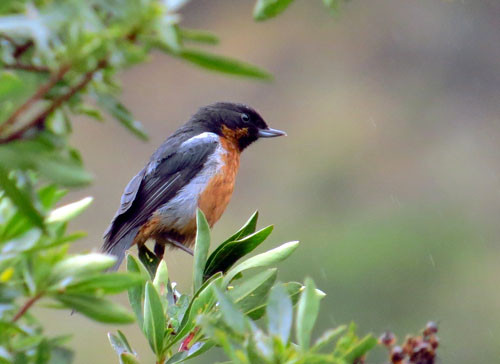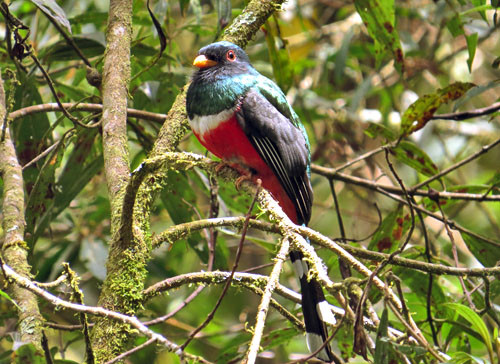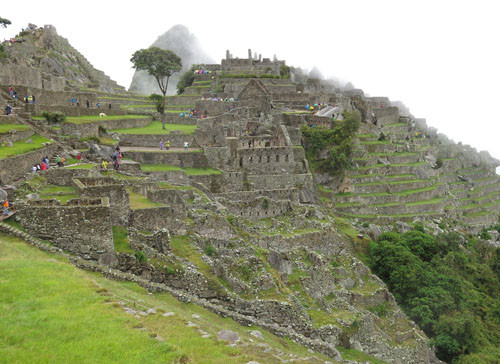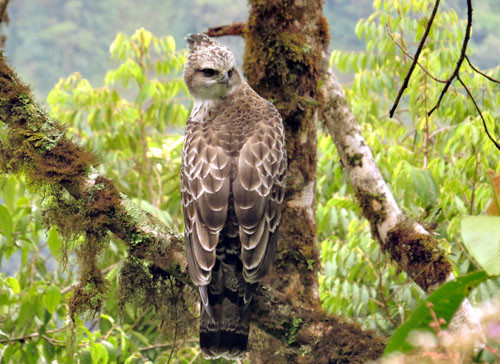 Our route takes us past a long-occupied territory of Black-and-chestnut Eagle, and one year this juvenile flushed from the roadside. Photo: Rich Hoyer
Our route takes us past a long-occupied territory of Black-and-chestnut Eagle, and one year this juvenile flushed from the roadside. Photo: Rich Hoyer The awe-inspiring Inca ruins of Machu Picchu need no introduction, and any birding trip to this region of Peru should include a visit. We’ll take advantage of our time here to bird the Urubamba River valley as well as some high-elevation lakes and marshes before continuing on to the Manu Biosphere Reserve, without question one of the most exciting birding destinations in the world. We’ll stay at three lodges at progressively lower elevations along the road that descends the Kosñipata Valley from Acjanaco Pass down to Pillcopata. We’ll visit protected habitats ranging from orchid-laden cloud forest at the upper elevations, to the rich middle elevations where Andean Cocks-of-the-rock perform their mating displays right along the road, down to the uppermost reaches of the navigable Amazon river system with its tropical exuberance.
This tour can be taken with our Peru: The Cloud Forests of the Rio Mayo and Abra Patricia & Rainforest Lodges of the Madre de Dios tours.
Day 1: The trip begins at 6 p.m. in the lobby of our Lima International Airport area hotel. Night in Lima.
Day 2: We’ll fly early this morning to Cusco and board our bus for a day of birding as we work our way to the end of the road toward Machu Picchu. We’ll stop at a lake or two where we’ll likely see Andean Gull, Puna Ibis, White-tufted Grebe, and several kinds of ducks. Some of the birds inhabiting the rushes by the lakeshores could include Many-colored Rush-Tyrant, Wren-like Rushbird, and Plumbeous Rail, while nearby drier hillsides host the local Rusty-fronted Canastero and Bearded Mountaineer. Night in Ollantaytambo.
Day 3: We’ll depart very early this morning to catch the early train for our full day trip to Machu Picchu. From the train, we’ll see Torrent Duck and possibly White-capped Dipper on the Urubamba River, and on arrival, we’ll meet our local guide and board a bus for the short ride to the ruins, situated on a high ridge with spectacular views of the Urubamba River below. Our English-speaking guide will tell us about the geological and human history of the region as we spend a few hours slowly walking through the ruins, all the while watching for White-tipped Swifts overhead, looking for Inca Wren in the bamboo on the fringes of the ruins, and keeping an eye out for Northern Mountain Viscachas and Stenocercus lizards on the ruins themselves. After lunch, we’ll do some birding along the Urubamba River and have a brief opportunity to visit the gift shops before our late afternoon return train. Night in Ollantaytambo.
Day 4: We’ll depart by bus for the trip to the eastern slope of the Andes. We’ll make several stops as we climb over a couple of interior ridges and traverse some drier intermontane valleys before arriving at the last Andean pass, Acjanaco. Some birds we’ll likely see along the way include Mountain Caracara, Andean Flicker, Slender-billed Miner, and Mourning, Peruvian, and Ash-breasted Sierra Finches. Diversity increases as the habitats become moister and denser, with the endemic Creamy-crested Spinetail and very local Chestnut-breasted Mountain Finch possible. Near the pass, we’ll look for flocks in the patches of the humid treeline forest in hopes of encountering Scarlet-bellied Mountain Tanager, Golden-collared Tanager, White-browed Conebill, and Black-throated and Moustached Flowerpiercers. We’ll look particularly for Line-fronted and Scribble-tailed Canasteros, local species found only at high elevation or above treeline. As we descend the eastern slope of the Andes to our accommodations at 9400 feet, the forest becomes more continuous. The vast array of birds here includes White-collared Jay and Mountain Cacique, and we’ll hope to see mixed flocks of tanagers, flycatchers, and furnariids. In the evening we’ll go to a favorite spot where we’ve had good luck finding Swallow-tailed Nightjar. Night at Wayqecha Birding Lodge.
Day 5: At breakfast, we’ll be greeted by a dawn chorus of Great Thrushes, Glossy-black Thrushes, and Black-faced Brushfinches. We’ll have a full day in these uppermost elevations of the Kosñipata cloud forests, birding from the road that borders Manu National Park as well as on trails that enter the Amazon Conservation Association’s private reserve and research station. We’ll principally be birding along the road, almost certainly hearing Red-and-white Antpitta and Trilling Tapaculo, and with more than a bit of luck we’ll even see one or both. The lodge now has feeders, and possible hummingbirds here are the creatively named Shining Sunbeam and Amethyst-throated Sunangel, and other high-elevation specialties could include Gray-breasted Mountain-Toucan, Marcapata Spinetail, and Barred Fruiteater. We may return to Acjanaco Pass a few kilometers back up the road for any high-elevation birds we might have missed the day before, such as Puna Thistletail, Undulated Antpitta, Great Sapphirewing, or Grass Wren, the last an Andean resident recently split from North American Sedge Wren. Night at Wayqecha Birding Lodge.
Day 6: We’ll spend the bulk of this day making stops along the road, starting in the high-elevation cloud forests below our lodge at 9400 feet down to our next lodge at 4600 feet. Lower down, as we walk along this little-traveled road, we’ll keep an eye out for Masked Trogon, Crimson-mantled Woodpecker, Maroon-belted Chat-Tyrant, Inca Flycatcher, Blue-banded Toucanet, and a wide variety of other hummingbirds, flycatchers, and tanagers. The list of possible birds is all but overwhelming, and perhaps equally exciting are the myriad butterflies that come to seeps, puddles, and flowers. Lush, cloud-forest vegetation with flowers such as wild nasturtiums, fuchsias, Pitcairnia, and Bomarea (all attractive to hummingbirds) as well as fabulous vistas of undisturbed forest will make our day’s journey down the Manu Road memorable. Night in San Pedro.
Day 7: We’ll spend the day exploring the middle-elevation forests, concentrating on the habitats found from 6500 feet down to 4500 feet, home to many narrow-range specialties and an exceptionally comfortable climate. Birding these forests can be like visiting a bird buffet, with fancy quetzals and cotingas and mixed flocks of dazzling tanagers. Among the many possibilities are Crested and Golden-headed Quetzals, Amazonian Umbrellabird, Chestnut-backed Antshrike, Stripe-chested Antwren, Slaty Gnateater, Yungas Manakin, Andean and White-eared Solitaires, Deep-blue Flowerpiercer, and Golden, Paradise, Blue-necked, Golden-eared, and Orange-eared Tanagers. We sometimes get lucky with a troop of Geoffroy’s Woolly Monkeys in the roadside trees, and if it’s sunny, butterflies such as eighty-eights, jewels, and clearwings will continue to delight. We’ll visit a nearby Andean Cock-of-the-rock lek to watch up to ten or more males engaged in their strange mating dance at surprisingly close range. Hummingbirds at the lodge’s feeders and porterweed hedges should include Violet-fronted Brilliant, Many-spotted Hummingbird, and Booted Racket-tail, while Geoffroy’s Daggerbill, Wire-crested Thorntail, and White-bellied Woodstar are also possible at the flowers. We’ll also do some night birding here; we could find Rufescent Screech-Owl and Band-bellied Owl, but the real treat will be the Lyre-tailed Nightjar show: watching a male Lyre-tailed swoop across the sky at dusk is truly awesome. Night in San Pedro.
Day 8: After a pre-dawn breakfast we’ll spend the morning birding the lower foothill forests where more mixed flocks are our target. We’ll pay special attention to the stretch between 4500 and 2500 feet, which has relatively untouched forest, a rarity in the Andes as the climate is ideal for raising cash crops such as tea, coffee, and coca. In the past, we’ve seen many species restricted to this upper tropical zone, including Peruvian Piedtail, Versicolored Barbet, Ornate Stipplethroat, Cinnamon-faced Tyrannulet, Ornate Flycatcher, Black-backed Tody-Flycatcher, and Chestnut-breasted Wren. On one stretch of the road we’ll search for the Inti Tanager, first documented on WINGS tours in 2000 and 2003 and described finally in 2021. We’ll arrive at our next lodge with plenty of time to settle in before some late afternoon birding close to our rooms. Night at Villa Carmen.
Days 9–10: We’ll spend two full days at Villa Carmen. This birding lodge and biological research station owned by the Amazonian Conservation Association is in the transitional zone where the last low foothills of the Andes begin to flatten out into the Amazon Basin proper; while many of the species are Amazonian in affinity, some that are limited to the outer foothills are found only here. The possibilities are almost endless and include Uniform Crake, Hoatzin, Blue-headed and Chestnut-fronted Macaws, Yellow-billed Nunbird, Scarlet-hooded Barbet, Cuzco Warbler, Bamboo Antshrike, Black-throated Antbird, Rusty-belted Tapaculo, Ringed Antpipit, Johannes’s Tody-Tyrant, Hauxwell’s Thrush, and Band-tailed, Round-tailed, and Fiery-capped Manakins—in a word, tons of birds. We’ll make a short drive one day to visit a hummingbird feeding station where we may find Rufous-crested Coquette, Koepcke’s Hermit, and many other species. We’ll have the chance to go night birding here as well, and we should hear and possibly see Tawny-bellied Screech-Owl, Black-banded Owl, and Common Potoo. Nights at Villa Carmen.
Day 11: We’ll have final early morning at our Villa Carmen lodge, perhaps watching a morning flight of macaws or even making an attempt at pre-dawn owling. We’ll then retrace our path back up the Kosñipata Valley with possible short stops as we spot activity that catches our eyes or ears. After a picnic lunch at Acjanaco Pass we’ll continue to Cusco. Night in Cusco.
Day 12: You’ll have the early morning on your own to see the sights of the beautiful historic center of Cusco, and perhaps do a bit of shopping. Those who participate only on this tour will have their flights back to Lima, where the tour concludes, while those continuing on the second tour will have a mid-day flight to Puerto Maldonado.
Updated: 28 December 2022
Prices
- 2024 Tour Price : $5,690
- Single Occupancy Supplement : $870
Notes

Questions? Tour Manager: Greg Greene. Call 1-866-547-9868 (US or Canada) or (01) 520-320-9868 or click here to email.
* Tour invoices paid by check carry a 4% discount. Details here.
Maximum group size eight with one WINGS leader

